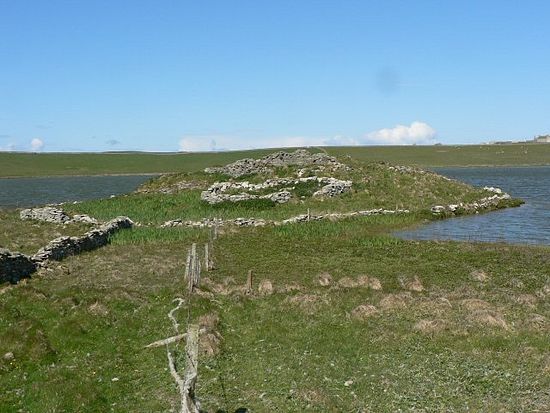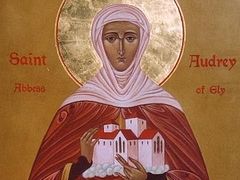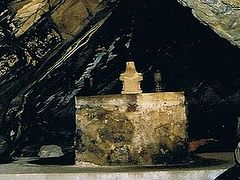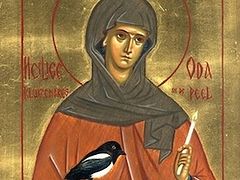St. Triduana (also Triduna, Tradwell), one of the most venerated female saints of Scotland, lived between the fourth and the eighth centuries. Despite the fact that Scottish people from the mainland and the isles off the Scottish shores used to make pilgrimages to the holy sites associated with the venerable woman over the centuries, almost no concrete details of this saint’s life survive. According to the most popular legend, St. Triduana was a holy virgin born in the city of Colossae in Phrygia in Asia Minor in the fourth century. Later she became a nun and together with several fellow-sisters and the saintly Bishop Regulus of Patras in Greece[1] travelled to Scotland where they brought a part of the relics of the Apostle Andrew the First-Called.
In Scotland St. Triduana led an ascetic life together with two other holy anchoresses at a spot called Roscoby in the former region of Forfarshire (now the council area of Angus). Beloved and venerated by everybody, St. Triduana healed people who came to her of eye infections. According to one legend, a local king named Nechtan fell in love with the beautiful Triduana. Having learned that the king loved her for her fine eyes, the virgin tore them out and gave them to the King. It is a late legend, but the truth is that Christians did believe that the Lord bestowed on her the ability to heal blindness.
The holy maiden of God Triduana reposed in the village of Restalrig near Edinburgh (now a village within the city of Edinburgh) where she spent the final years of her life. The holy relics of this saint were venerated at the site of her death in Restalrig though some of her relics may have been kept in Aberdeen as well. Near her church at Restalrig there existed a famous holy well of St. Triduana which cured all sorts of eye complaints. Numerous pilgrims came to her shrine at Restalrig throughout the Middle Ages. During the Scottish Reformation the shrine was destroyed in 1560.
Today Restalrig is still a quiet and peaceful place and there is a parish church in honor of St. Margaret and a chapel attached to its south-west corner in honor of St. Triduana, the wonderworker of all Scotland. Archeological excavations carried out in recent times proved that a holy well of St. Triduana existed in Restalrig with a church built over it. The church consisted of two storeys; it also had a chapter house and a piscina (a stone basin near the altar in Catholic and pre-Reformation churches for draining water used in the Mass) installed just over or near the well. The church was greatly honored and endowed by several medieval kings of Scotland. The first mention of Restalrig church, which housed the saint’s relics, dates back to the twelfth century.
The church was rebuilt or extensively enlarged in the fifteenth century by order of King James III of Scotland (1451-1488). This grew into one of the most splendid churches in all Scotland, richly adorned, with an excellent choir, and having thirty-two altars. James III also founded the royal chapel of St. Triduana there in 1477, and it was completed by 1487. It consisted of two chapels: the upper and lower ones, the lower part being used as a vault. During the Reformation the splendid Restalrig church was nearly completely destroyed and the relics disappeared.
It was only in 1836 that the parish church was rebuilt for the villagers by the architect William Burn (who also used some of the materials of the original church) and was dedicated in honor of St. Margaret. The miraculously surviving hexagonal lower chapel of St. Triduana (the lower part of the royal chapel founded by King James) was rediscovered later in the same century, and this unique gem was also restored in 1907. This ancient chapel (also sometimes called “aisle” and “well-house”) still preserves its medieval charm and glory inside and is crowned by a statue of its patron-saint, Triduana. The church and chapel belong to the Church of Scotland. Now this place is again a destination for pilgrimages. The city of Edinburgh also has a Roman Catholic church in honor of Sts. Ninian and Triduana.
There are many stories relating the miraculous help of St. Triduana down the centuries. Some of them can be found in the Acta Sanctorum (“Acts of the Saints”)—the encyclopedic collection of Lives of Saints with a critical examination in sixty-eight volumes, which was created between 1643 and 1940 by Jesuits. According to one story, a certain woman who lived in England lost her eyesight. St. Triduana appeared to her in a vision and commanded to go to Restalrig as soon as possible and pray there before her shrine with the relics. The woman obeyed the command—and was miraculously healed. Later a daughter of the same woman lost her eyesight too—she prayed to the saint and her vision was restored. Another time, Bishop John of Caithness, who lived in the twelfth century, was blinded by a Count of Orkney as a punishment for some misdeed and his tongue was pulled out. Bishop John visited the tomb of St. Triduana, and his sight and speech were completely recovered.
Outside Ristalrig, Triduana is the patron-saint of Kintradwell (called after her) in Caithness. Chapel dedications to this saint are also known at Loth (St. Trolla’s) in Sutherland, the Scottish Highlands region, and at Ballachly in Caithness. As for Ballachly, the latest archeological excavations have proved the existence of a very early monastic settlement, a chapel, a Christian cemetery and crosses on this site. In all probability there was a monastery or a church there which even predated St. Columba’s mission!
But the second most important shrine associated with our saint was on Papa Westray—one of the Orkney Islands in Scotland, where nowadays only ruins of the walls of her medieval chapel can be seen. In the past it was one of the most popular holy places in Orkney.
Historical documents from the eighteenth century contain records of countless cases of miracles that have occurred there from olden times. Though by that time Orcadians had long adopted Protestantism (and as we know followers of this confession do not venerate saints as a rule), the influx of pilgrimages to Papa Westray did not cease for centuries after the Reformation. For example, one young man in the eighteenth century lost his eyesight—he travelled to Papa Westray, washed his face in the loch (lake) near the saint’s chapel and was cured. And this is a very common example of miracles.
According to evidence from the post-Reformation period, many believers would still bring small stones or coins to the chapel of St. Triduana and thank her for her help. Often those suffering from eye diseases came to Papa Westray again and again until they were completely healed. Even as late as the nineteenth century believers continued to flock to the saint’s chapel ruins in order to pray and ask for healing, and local Presbyterian pastors were not able to prevent them from doing this. St. Triduana is depicted on stained glass of the twelfth-century St. Magnus Cathedral (the Church of Scotland) in the town of Kirkwall on Orkney—it is the most northerly cathedral in Britain. We hope that the veneration of this ancient woman-saint of Scotland, who is closely linked with Edinburgh, will revive among Orthodox Christians as well.
Holy mother Triduana of Scotland, pray to God for us!







